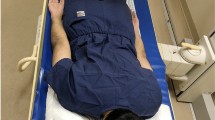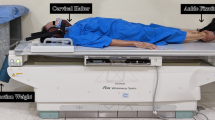Abstract
Study design
Retrospective chart and radiographic review.
Objective
The purpose of this study is to determine if both traction and side-bending radiographs yield the same Lenke classification.
Summary of background date
Supine side-bending radiographs are used to evaluate curve flexibility and assign Lenke classification in Adolescent Idiopathic Scoliosis (AIS). Supine traction radiographs are another tool used by treating surgeons to gauge flexibility and appropriate levels for spinal fusion in AIS.
Methods
Retrospective chart and radiographic review were performed on AIS patients that underwent a posterior spinal fusion from 2008 to 2017. Cobb angles and Lenke classifications were determined on all upright posterioanterior (PA) spine radiographs, supine traction radiographs, and four supine bending radiographs. Statistical analysis using independent t tests and chi-square tests as appropriate were compared between patients with or without discordant Lenke classifications with p value set at < 0.05 for statistical significance.
Results
184 patients met inclusion criteria, 36 males and 148 females. The average Cobb angle for the proximal thoracic (PT) curve was 27.2°, main thoracic (MT) curve was 60.5°, and thoracolumbar/lumbar (TL/L) curve was 48.0°. Significantly less curve correction was found with supine traction radiographs compared with bending radiographs: PT (23.1° vs 18.9°, p < 0.001), MT (38.9° vs 37.9°, p = 0.015), and TL/L (25.9° vs. 18.0°, p < 0.001). Lenke Classification was found concordant in 151/184 (82.1%). Traction views in the discordant Lenke classification group demonstrated less curve correction than those in the concordant group: PT (27.4° vs. 22.1°, p = 0.011), MT (45.3° vs. 37.5°, p < 0.001), and TL/L (29.3° vs 25.1°, p = 0.019).
Conclusion
Supine traction and supine bending radiographs provided a concordant Lenke classification 82.1% of the time. However, supine traction radiographs demonstrate less curve correction, a higher Lenke classification, and underestimated the TL/L curve correction to a greater degree. A single supine traction film is not an adequate substitute to side-bending radiographs when determining Lenke classification in patients with Adolescent Idiopathic Scoliosis.
Level of evidence
III.
Similar content being viewed by others
References
Lenke LG, Betz RR, Clements D, Merola A, Haher T, Lowe T, Newton P, Bridwell KH, Blanke K (2002) Curve prevalence of a new classification of operative adolescent idiopathic scoliosis: does classification correlate with treatment? Spine (Phila Pa 1976) 27(6):604–611
Vaughan JJ, Winter RB, Lonstein JE (1996) Comparison of the use of supine bending and traction radiographs in the selection of the fusion area in adolescent idiopathic scoliosis. Spine (Phila Pa 1976) 21(21):2469–2473
Liu RW, Teng AL, Armstrong DG, Poe-Kochert C, Son-Hing JP, Thompson GH (2010) Comparison of supine bending, push-prone, and traction under general anesthesia radiographs in predicting curve flexibility and postoperative correction in adolescent idiopathic scoliosis. Spine (Phila Pa 1976) 35(4):416–422
Klepps SJ, Lenke LG, Bridwell KH, Bassett GS, Whorton J (2001) Prospective comparison of flexibility radiographs in adolescent idiopathic scoliosis. Spine (Phila Pa 1976) 26(5):E74–E79
Lenke LG, Betz RR, Harms J et al (2001) Adolescent idiopathic scoliosis: a new classification to determine extent of spinal arthrodesis. J Bone Joint Surg Am 83-A:1169–1181
Cheung KM, Luk KD (1997) Prediction of correction of scoliosis with use of the fulcrum bending radiograph. J Bone Joint Surg Am 79(8):1144–1150
Luk KD, Don AS, Chong CS, Wong YW, Cheung KM (2008) Selection of fusion levels in adolescent idiopathic scoliosis using fulcrum bending prediction: a prospective study. Spine (Phila Pa 1976) 33(20):2192–2198
Li J, Hwang S, Wang F, Chen Z, Wu H, Li B, Wei X, Zhu X, Li M (2013) An innovative fulcrum-bending radiographical technique to assess curve flexibility in patients with adolescent idiopathic scoliosis. Spine (Phila Pa 1976) 38(24):E1527–E1532
Watanabe K, Kawakami N, Nishiwaki Y, Goto M, Tsuji T, Obara T, Imagama S, Matsumoto M (2007) Traction versus supine side-bending radiographs in determining flexibility: what factors influence these techniques? Spine (Phila Pa 1976) 32(23):2604–2609
Ibrahim T, Gabbar OA, El-Abed K, Hutchinson MJ, Nelson IW (2008) The value of radiographs obtained during forced traction under general anaesthesia in predicting flexibility in idiopathic scoliosis with Cobb angles exceeding 60 degree. J Bone Joint Surg Br 90(11):1473–1476
Hamzaoglu A, Ozturk C, Enercan M, Alanay A (2013) Traction X-ray under general anesthesia helps to save motion segment in treatment of Lenke type 3C and 6C curves. Spine J 13(8):845–852
Omidi-Kashani F, Hasankhani EG, Moradi A, Toossi KZ, Nojomi M (2013) Modified fulcrum bending radiography: A new combined technique that may reflect scoliotic curve flexibility better than other conventional methods. J Orthop 10(4):172–176
Cheung WY, Lenke LG, Luk KD (2010) Prediction of scoliosis correction with thoracic segmental pedicle screw constructs using fulcrum bending radiographs. Spine (Phila Pa 1976) 35(5):557–561
Hamzaoglu A, Talu U, Tezer M, Mirzanli C, Domanic U, Goksan SB (2005) Assessment of curve flexibility in adolescent idiopathic scoliosis. Spine (Phila Pa 1976) 30(14):1637–1642
Funding
No funding was received for this work.
Author information
Authors and Affiliations
Contributions
SM: Made substantial contributions to analysis and interpretation of data, assisted in drafting the work, approved version to be publish, and agree to be accountable for all aspects of the work. Authorship requirement. TS: Made substantial contributions to the design of the work, assisted in drafting the work, approved version to be publish, and agree to be accountable for all aspects of the work. AK: Made substantial contribution to the acquisition of data, assisted in drafting the work, approved version to be publish, and agree to be accountable for all aspects of the work. VT, VP, RM, HI: Made substantial contribution to the design of the work, revised it critically for important intellectual content, approved version to be publish, and agree to be accountable for all aspects of the work.
Corresponding author
Ethics declarations
Conflict of interest
The author(s) declare that they have no conflicts of interest.
Ethics approval
This study was approved by the institutional review board at Shriner’s Hospital in Lexington, KY, USA.
Informed consent
Informed consent not needed secondary to retrospective nature of study.
Rights and permissions
About this article
Cite this article
Malik, S., Schmicker, T., Kopiec, A. et al. Preoperative supine traction radiographs often result in higher Lenke classifications than supine bending radiographs in adolescent idiopathic scoliosis. Spine Deform 9, 1049–1052 (2021). https://doi.org/10.1007/s43390-020-00271-6
Received:
Accepted:
Published:
Issue Date:
DOI: https://doi.org/10.1007/s43390-020-00271-6




